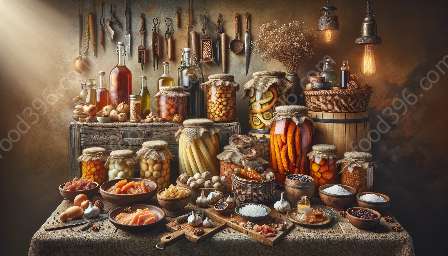Preserving meat has been a critical practice throughout history, playing a significant role in shaping food culture and history. This article delves into the fascinating world of historical techniques for preserving meat, including curing, smoking, and salting.
The Importance of Meat Preservation in History
Meat preservation was essential for our ancestors, allowing them to store and consume meat over extended periods without spoilage. With limited refrigeration methods, early civilizations developed various techniques to preserve meat that have contributed to our understanding of food culture and history.
Curing
Curing is one of the oldest methods for preserving meat and involves the use of salt, nitrates, and sugar to inhibit bacterial growth and extend the shelf life of meat. This technique was widely practiced by ancient civilizations, such as the Egyptians and Romans, who used salt as a primary preservative. The process of curing not only preserved the meat but also imbued it with unique flavors, contributing to the rich tapestry of food culture and history.
Types of Curing
- Dry Curing: In dry curing, the meat is coated with a mixture of salt and spices and then left to air-dry. This method was commonly used for preserving whole cuts of meat, such as hams and bacon, and was an integral part of traditional food culture and history.
- Brine Curing: Brine curing involves soaking the meat in a saltwater solution, often flavored with herbs and spices, to impart additional flavors and preserve the meat. This method was prevalent in coastal regions and contributed to the development of diverse culinary traditions.
Smoking
Smoking is another ancient technique that not only preserved meat but also added a distinct flavor profile to it. The process involves exposing the meat to smoke from burning wood or other materials, which imparts a smoky aroma and helps inhibit bacterial growth. Smoking was widely practiced by indigenous cultures and early settlers, leaving an indelible mark on food culture and history.
Traditional Smokehouses
Traditional smokehouses were used to smoke meats, providing an environment where the meat could be slowly cured and flavored by the smoke. This method not only preserved the meat but also created unique regional variations in smoked meats, reflecting the diversity of food culture and history.
Salting
Salting, also known as dry curing, involves coating the meat in salt to draw out moisture and inhibit the growth of bacteria. This method was prevalent in regions where access to fresh water was limited and played a crucial role in meat preservation, contributing to the regional diversity in food culture and history.
Effect on Food Culture and History
The historical techniques for preserving meat have had a profound impact on food culture and history, shaping the development of culinary traditions and regional cuisines. The preservation methods not only extended the availability of meat but also influenced the flavors and cooking practices of different cultures, creating a rich tapestry of preserved meat dishes that continue to be celebrated.
Conclusion
Exploring the historical techniques for preserving meat provides a fascinating insight into the ingenuity and resourcefulness of our ancestors. These time-honored methods not only ensured the availability of meat throughout the year but also contributed to the rich and diverse food culture and history that we continue to cherish today.

